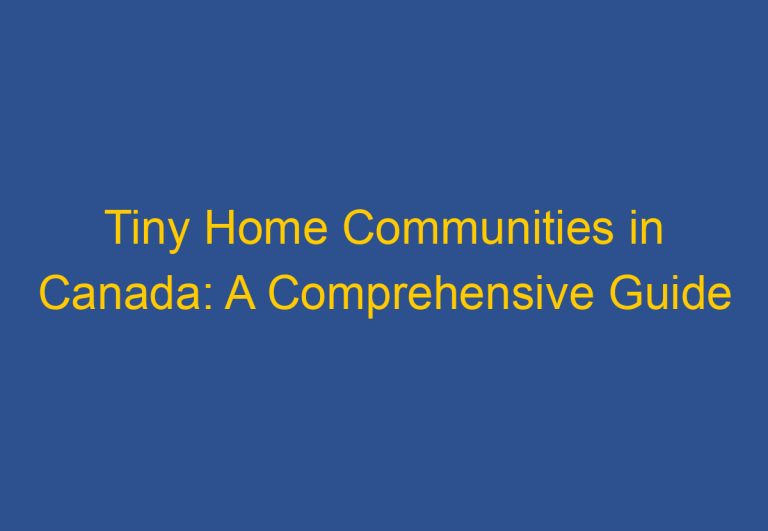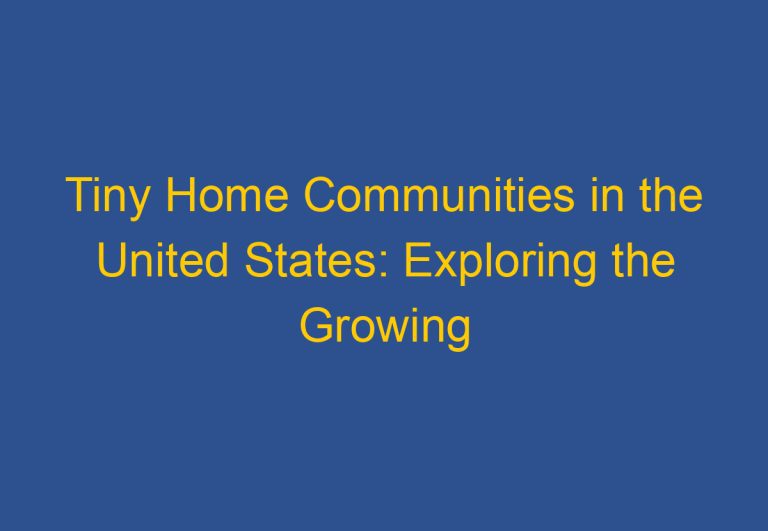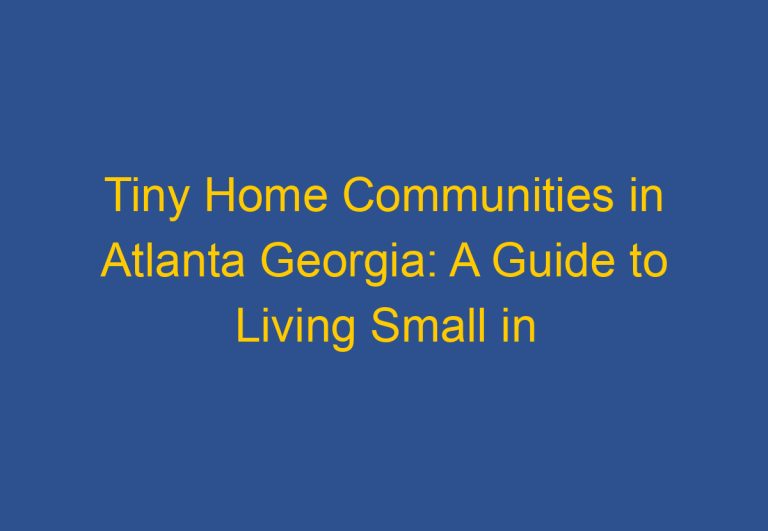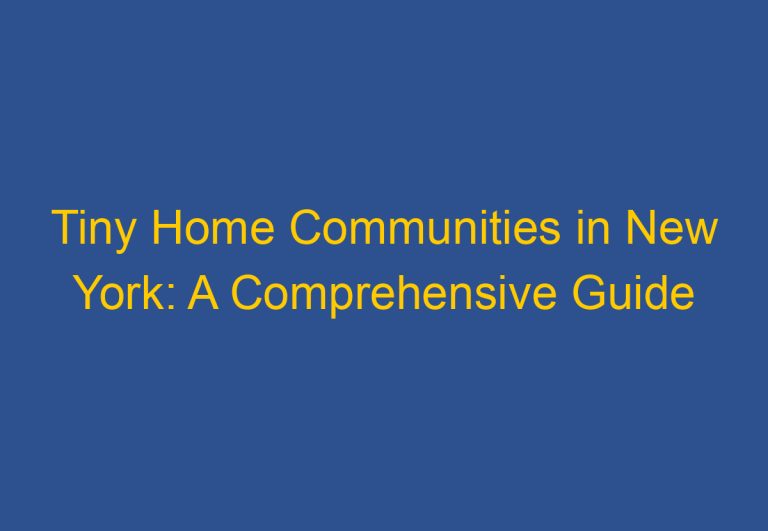Tiny Home Communities in CA: A Growing Trend in Affordable Housing
Tiny homes have been gaining popularity in recent years, and California is no exception to this trend. In fact, California is home to some of the most innovative and affordable tiny home communities in the country. These communities offer a unique lifestyle that is both environmentally friendly and socially engaging.

Living in a tiny home community in California is a great way to reduce living expenses and simplify one’s life. Many of these communities offer a variety of amenities such as communal gardens, shared workspaces, and recreational areas. Additionally, living in a tiny home community provides an opportunity to connect with like-minded individuals who share similar values and interests.
Despite the challenges of finding affordable housing in California, tiny home communities are providing an alternative solution for those seeking a more sustainable and community-oriented lifestyle. Whether you are looking to downsize, reduce your carbon footprint, or simply connect with others, there are many tiny home communities in California that offer a unique and fulfilling way of life.
Understanding Tiny Home Communities

Tiny home communities are becoming increasingly popular in California as more people seek a simpler and more sustainable lifestyle. These communities consist of clusters of small, self-sufficient dwellings ranging from 100 to 400 square feet, purposefully designed to foster strong bonds and shared values among residents. Here are some key things to know about tiny home communities.
Legality and Zoning
One of the biggest challenges for tiny home communities is navigating the complex web of zoning and building codes. However, the good news is that tiny homes are legal in California. The state adopted Appendix Q Tiny Houses of the 2018 International Residential Code (IRC) on January 1, 2020, making it mandatory at the state level. This means that tiny houses built to Appendix Q standards are now recognized as a legal form of dwelling in California. It is important to do your research before choosing a location for your tiny home and ensure that the community you choose is legal and zoned for tiny homes.
Benefits of Tiny Living
Living in a tiny home community offers many benefits. For starters, it is a sustainable lifestyle choice that reduces your carbon footprint. Tiny homes consume less energy and produce less waste, making them an eco-friendly option. Additionally, tiny homes are much more affordable than traditional homes, allowing residents to save money and live debt-free. Tiny home communities also offer a sense of community and belonging, as residents share common spaces and work together to maintain the community.
Types of Tiny Homes
There are many different types of tiny homes, each with its unique benefits. Movable tiny houses are built on trailers, making them easy to move from place to place. Accessory dwelling units (ADUs) are tiny homes that are built on existing residential properties and can be used as guest houses, home offices, or rental units. Some tiny homes are designed to be completely off-grid, relying on solar power and rainwater collection for all their needs. Regardless of the type of tiny home, they all offer a minimalist lifestyle that allows residents to focus on what truly matters in life.
In summary, tiny home communities are a unique and sustainable living option that offers many benefits. By understanding the legality and zoning, benefits of tiny living, and types of tiny homes, you can make an informed decision about whether a tiny home community is right for you.
Key Locations and Communities

Northern California Highlights
Northern California is home to a number of tiny home communities that offer a unique and sustainable lifestyle. One such community is Park Delta Bay, located in Isleton. This community is situated on the Sacramento River and offers residents access to a marina, fishing, and boating. Another community in the area is Ojai, which features a variety of tiny homes and is known for its beautiful scenery and laid-back lifestyle.
San Francisco is another great location for tiny home enthusiasts. The city has a number of tiny home communities, including one in Oakland. This community features a variety of tiny homes, each with its own unique design and style. San Francisco is also home to a number of tiny home builders, making it a great place to start your tiny home journey.
Southern California Hotspots
Southern California is home to some of the most popular tiny home communities in the state. One of the most well-known is in Los Angeles, which features a variety of tiny homes and is known for its vibrant community. San Diego is another great location for tiny home enthusiasts, with a variety of communities to choose from.
Malibu is another popular location for tiny home living, with a number of communities that offer residents access to beautiful beaches and stunning views. Palm Springs is also a great location, with a number of communities that offer residents access to hot springs and desert landscapes.
Overall, California is a great place to live if you’re interested in tiny home living. With a variety of communities to choose from, each with its own unique style and amenities, there’s something for everyone.
Amenities and Lifestyle

When it comes to tiny home communities in California, there are a variety of amenities and lifestyle options available to residents. These communities offer a unique lifestyle that promotes minimalism, sustainability, and community living.
Community Features
Many tiny home communities offer a range of community features, such as laundry facilities, kitchen facilities, and living rooms. Some communities also offer luxury amenities like swimming pools, hot tubs, and fitness centers. For those who enjoy outdoor activities, some communities offer hiking trails, pickleball courts, and other outdoor sports facilities. Additionally, some communities are pet-friendly and offer a variety of activities and events for residents, such as workshops and movie nights.
Outdoor and Social Activities
In addition to community features, tiny home communities in California also offer a range of outdoor and social activities. Residents can participate in social events and activities that promote community living and sustainability. These events may include workshops on sustainable living, gardening, and composting, as well as community-wide events like potlucks and movie nights.
For those who enjoy outdoor activities, many communities offer hiking trails, bike paths, and other outdoor recreation opportunities. Some communities also offer access to nearby parks and natural areas, where residents can enjoy the beauty of California’s natural landscapes.
Overall, tiny home communities in California offer a unique and sustainable lifestyle that promotes community living and minimalism. With a range of amenities and lifestyle options available, there is something for everyone in these communities.
Buying and Renting in Tiny Home Communities

Real Estate Considerations
Tiny home communities offer a unique opportunity for those looking to downsize, live off-grid, or own a vacation home. When considering buying or renting a tiny home in a community, there are a few real estate considerations to keep in mind.
Firstly, affordability is a major factor in the tiny home market. While the real estate market in California can be expensive, tiny homes offer a more affordable option for those looking to own a home. Additionally, the cost of living in a tiny home community may be lower than in traditional neighborhoods.
It’s also important to consider the flexibility that comes with owning a tiny home. Many communities, such as Tiny House Block and Tiny Village, offer both short and long-term rentals, as well as the option to purchase land for permanent residency. This flexibility allows for more options when it comes to living arrangements.
Unique Community Opportunities
Tiny home communities offer unique community opportunities that may not be available in traditional neighborhoods. For example, Tiny House Block, founded by Melissa and Jon Block, is one of the only legal tiny home communities in Southern California. This community offers nature lovers a memorable stay while connecting authentically in the 21st century.
Other communities, such as Forever Tiny Homes and Sierra Tiny Houses, offer off-grid living options for those looking to live a more sustainable lifestyle. Airbnb rentals are also available in some tiny home communities, offering a unique vacation experience for those looking to get away.
Overall, tiny home communities offer a unique and affordable housing option, with a variety of real estate and community opportunities to choose from. Whether looking to downsize, own a vacation home, or live off-grid, there is a tiny home community in California that can meet those needs.
Frequently Asked Questions

What are the top-rated tiny home communities in California?
California is home to many tiny home communities, and some of the top-rated ones include Park Delta Bay in Isleton, The Sanctuary in Los Angeles, and Lemon Cove Village in Lemon Cove. These communities offer a range of amenities and facilities, including access to hiking trails, community gardens, and shared spaces.
Where in Southern California can I find tiny house communities?
Southern California is home to several tiny house communities, including the Tiny House Block in San Diego, the Tiny House Village in El Cajon, and the Tiny House Village in Joshua Tree. These communities offer a range of housing options and are located in scenic areas with access to outdoor recreation.
Are there any luxury tiny home communities located in California?
Yes, there are several luxury tiny home communities in California, including the LuxTiny Community in Lakeside, the Tiny House Village in Sonoma, and the Tiny Home Village in San Francisco. These communities offer high-end amenities and facilities, such as swimming pools, fitness centers, and on-site restaurants.
How can I find affordable tiny home communities in California?
There are several ways to find affordable tiny home communities in California, including searching online directories, attending tiny home shows and events, and contacting local housing organizations. Some affordable options include the Tiny House Village in Fresno, the Tiny House Block in San Diego, and the Tiny House Village in El Cajon.
What are the regulations for parking a tiny home in California?
The regulations for parking a tiny home in California vary depending on the location and the type of tiny home. Generally, tiny homes must be parked on a permanent foundation and comply with local zoning and building codes. Some communities may have additional regulations, such as size restrictions or parking fees.
What is the average purchase price for a tiny home in California?
The average purchase price for a tiny home in California varies depending on the size, location, and amenities of the home. Generally, prices range from $30,000 to $100,000, with some luxury models costing upwards of $200,000. It is important to research different options and consider factors such as financing, maintenance costs, and resale value before making a purchase.






